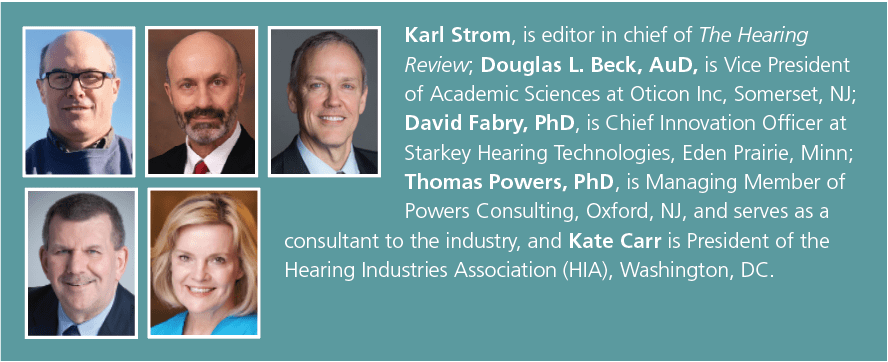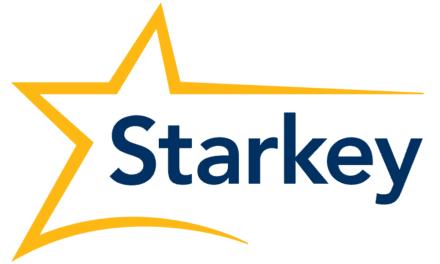Opinion | October 2020 Hearing Review
By Karl Strom, Douglas L. Beck, AuD, David Fabry, PhD, Thomas Powers, PhD, and Kate Carr
On September 8, the US Preventative Services Task Force (USPSTF) draft recommendation stated there is not enough evidence to recommend physicians screen for hearing loss in adults age 50 and older without signs or symptoms of hearing loss.1 The Task Force’s conclusion was essentially the same as the one it came to 8 years ago in 2012,2 following a 1996 recommendation that primary care physicians should “periodically question older adults about their hearing, counsel them about hearing aids, and make referrals when appropriate.”3
Probably, for most people in our profession, the initial reaction is outrage. Anyone in hearing healthcare knows, and has read countless studies about, the pervasiveness of untreated hearing loss and its detrimental effects on individuals and society. In particular, hearing loss is one of the leading culprits in the epidemic of older persons experiencing social isolation4 and loneliness.5 Not surprisingly, negative feelings about self-worth6 and depression7 are increased in people with untreated hearing loss. Hearing loss has been linked to cognitive impairment and dementia like Alzheimer’s disease,8-10 and has even been shown to reorganize the processing centers of the brain.11 Researchers have linked untreated hearing loss to a variety of chronic health conditions and risk factors,12 including fall/balance issues and cardiovascular disease.13-15
It’s true that scientists, doctors, and audiologists are quick to note that “correlation does not imply causality.” Yet the research is increasingly clear that hearing loss elevates the risk of dementia,16 negatively impacts general health, degrades aspects of memory and cognitive function10 and overall quality of life,17 places burdens on marital/conjugal relationships,18,19 negatively impacts income,20 and more.
All of which begs outrage! How can the USPSTF not recommend that physicians screen for hearing loss in older adults?
The answer is: USPSTF must rely on solid scientific evidence. They believe there still isn’t enough hard science to demonstrate that current hearing screenings provide better patient outcomes, such that the USPSTF recommends that every general practice (GP) physician in the United States screen every person age 50 years or older. Each question the GPs ask represents a significant potential investment in healthcare time and money, and each question asked may lead to greater future ramifications for government-sponsored healthcare spending. Screening questions/procedures, therefore, need to be very well supported through evidence-based, peer-reviewed studies, and at this time, the USPSTF views the current evidence for screening efficacy and outcomes as lacking.
This leads us to contrition, or the remorseful admission that maybe we haven’t done a good enough job of studying and illuminating this very crucial area. Of note and of great importance to this discussion, MarkeTrak has continuously shown (across decades) that the most important social influencer with respect to seeking hearing help is the family physician.21
From our perspective, pure-tone (PT) screenings are not perfect measures of hearing for anyone.22 Diagnostic PT measures generally use six data points (250, 500, 1000, 2000, 4000, 8000 Hz) to represent the entirety of the human hearing spectrum (20-20,000 Hz). PT screenings usually measure 3 or 4 specific octave tone thresholds across the speech spectrum, and the pass/fail criteria, presentation levels, background noise, calibration technique, and threshold protocol are variables which impact the sensitivity and specificity of “hearing screenings.”
Further, the USPSTF protocol was for people 50 years of age. Our thought is that, in the absence of hearing or listening complaints, age 50 may be too young for a single PT screening test to make a difference—although it depends significantly on each individual being screened.
Another criticism of PT thresholds: they are sounds nobody hears in daily life. It seems likely the reason PT screenings (with all of their unknown sensitivities, specificities, protocols, calibration issues, background noise, and more) haven’t panned out is that listening (ie, the ability to attribute meaning to sound) is pragmatically more important than hearing. Of course, listening is built on the foundation of hearing, but mere audibility is not enough to determine how well someone gets by in noisy or difficult acoustic situations with the hearing they have. Hearing care professionals know that 10 people can have the same or similar pure-tone audiograms and have 10 entirely different auditory experiences. The ability of the human brain to untangle sound, comprehend, and apply meaning to it is why we are at the top of the food chain. Indeed, AAA, ASHA, and IHS each clearly state in their Best Practice guidelines that speech-in-noise testing is required because simple pure-tone testing does not provide enough information for professional diagnosis or management.23-27
Therefore, it may be prudent to offer a more representative and pragmatic two-part screening protocol based on the ability to hear (ie, perceive sound) and the ability to listen (ie, comprehend sound). A two-part approach could use pure-tones or speech sound (ie, phoneme) detection to represent hearing ability, and perhaps a standardized pass/fail speech-in-noise test at a fixed signal-to-noise ratio to represent listening ability. The total test time for an adult would be 3-5 minutes, and would result in a more accurate representation of a functional auditory system relative to communication. Of course, these are just examples as to how screenings might be updated in the 21st century. We would anticipate a national association-based think tank of subject matter experts would need to be assembled to design, test, and recommend an actual two-part screening recommendation and protocol.
The bottom line is we need better data. Doing the same thing over and over and expecting a different result is the definition of insanity. More than 25 years ago, Fred Bess, PhD, and Jack Paradise, MD, published an important article in Pediatrics titled, “Universal Screening for Infant Hearing Impairment: Not Simple, Not Risk Free, and Not Presently Justified.”28 Because both of these distinguished researchers knew very well the importance of universal newborn hearing screening (UNHS), their publication can now be viewed as a singularly courageous act of scientific contrition in hearing healthcare. Although they doubtlessly suffered the wrath of their colleagues, they said what needed to be said: Show us the evidence! All of which helped inspire and pave the way for the publication of the stellar research only 5 years later from Christine Yoshinaga-Itano29 and many other pediatric audiologists.
So then, we can be contrite for not having enough evidence to refute the recent USPSTF recommendation. It would be downright apostasy, however, for anyone in hearing healthcare to contend that physicians should not screen older adults for hearing loss at age 65-68 years or some similar landmark, including the “Welcome to Medicare” examination which currently includes hearing and balance screening questionnaires—not audiometric testing—that may be administered only by a physician or “qualified non-physician practitioner” (ie, a physician assistant, nurse practitioner, or clinical nurse specialist).
As noted above, untreated hearing loss is a huge, well-documented chronic health problem for older adults, and the literature continues to pour in about the role of good hearing in overall health, quality of life, and active aging. We urge hearing care professionals and their associations, consumer advocates, industry, and all stakeholders to educate Members of Congress who fund federal agencies, including HHS, NIH, NIDCD, and the research community, about the need to support research in this area—and fast!
In the end, it doesn’t really matter if we’re outraged or contrite. We’re reminded of the old question, “When is the best time to plant a tree?” The best time was 20 years ago; the second-best time is today. We need research on hearing screening right now, because this is far too big a health issue to let pass for another 8 years.
The opinions and viewpoints expressed here are those of the authors and do not necessarily reflect those of their companies/associations.
References
- United States Preventive Services Task Force (USPSTF). US Preventive Services Task Force Issues Draft Recommendation Statement on Screening for Hearing Loss in Older Adults. September 8, 2020. Available at: https://www.uspreventiveservicestaskforce.org/uspstf/sites/default/files/file/supporting_documents/hearing-loss-older-adults-screening-draft-rec-bulletin.pdf
- US Task Force Finds Insufficient Evidence for Benefits of Adult Hearing Loss Screening in Primary Care Settings. August 14, 2012. Available at: https://hearingreview.com/hearing-loss/us-task-force-finds-insufficient-evidence-for-benefits-of-adult-hearing-loss-screening-in-primary-care-settings
- USPSTF. Final Recommendation Statement–Hearing Impairment: Screening, 1996. January 1, 1996. Available at: https://www.uspreventiveservicestaskforce.org/uspstf/recommendation/hearing-impairment-screening-1996
- Kaufmann L. Social Engagement and Hearing Loss. April 17, 2019. Available at: https://hearingreview.com/resource-center/white-papers/special-report-social-engagement-hearing-loss
- Sung Y-K, Li L, Blake C, Betz J, Lin FR. Association of hearing loss and loneliness in older adults. J Aging Health. 2015; Sep;28(6):979-994.
- Bray V. Depression, Hearing Loss, and Treatment with Hearing Aids. April 20, 2019. Available at: http://info.hearingreview.com/depression-hearing-loss
- Li C-M, Zhang X, Hoffman HJ, et al. Hearing Impairment Associated With Depression in US Adults, National Health and Nutrition Examination Survey 2005-2010. JAMA Otolaryngol Head Neck Surg. 2014;140(4):293-302.
- Gurgel RK, Ward PD, Schwartz S, et al. Relationship of hearing loss and dementia: A prospective, population-based study. Otol Neurotol. 2014 [Jun]; 35(5):775-781.
- Wayne RV, Johnsrude IS. A review of causal mechanisms underlying the link between age-related hearing loss and cognitive decline. Ageing Res Rev. 2015 Sept;23(Part B):154-166.
- Livingston G, Huntley J, Sommerlad A, et al. Dementia prevention, intervention, and care: 2020 report of the Lancet Commission. Lancet. 2020 [Aug 8]; 396(10248):413-446.
- Sharma A, Glick H. Cortical neuroplasticity in hearing loss: Why it matters in clinical decision-making for children and adults. Hearing Review. 2018 [July];25(7):20-24.
- Abrams H. Hearing loss and associated comorbidities: What do we know? Hearing Review. 2017;24(12):32-35.
- Lin FR, Ferrucci L. Hearing Loss and Falls Among Older Adults in the United States. Arch Intern Med. 2012 [Feb 27];172(4): 369-371.
- Lubetzky AV, Gospodarek M, Arie L, et al. Auditory Input and Postural Control in Adults: A Narrative Review. JAMA Otolaryngol Head Neck Surg. 2020;146(5):480-487.
- Friedland DR, Cederberg C, Tarima S. Audiometric pattern as a predictor of cardiovascular status: Development of a model for assessment of risk. Laryngoscope. 2009 Mar;119(3):473-86.
- Johns Hopkins Medicine. Hearing Loss Linked to Accelerated Brain Tissue Loss. January 22, 2014. Available at: https://www.hopkinsmedicine.org/news/media/releases/hearing_loss_linked_to_accelerated_brain_tissue_loss_
- Kochkin S, Rogin C. Quantifying the obvious: The Impact of hearing instruments on quality of life. Hearing Review. 2000;7(1):6-34. Available at: https://hearingreview.com/wp-content/uploads/2019/01/KochkinRogin_QuantifyingObvious_0100HR.pdf
- Galloway J, Zhang V, Marnane V, Hou S, Stewart G, Bardy F. The impact of unilateral hearing loss on adult life. Hearing Review. 2019;26(4)[Apr]:10-14.
- Tjørnhøj-Thomsen T, Philipsen HH. Hearing loss as a social problem: A study of hearing-impaired spouses and their hearing partners. February 12, 2019. Available at: https://hearingreview.com/hearing-loss/patient-care/hearing-loss-as-a-social-problem
- Strom KE. Hearing loss and its impact on household income: A special report on new data generated by the Better Hearing Institute. October 2, 2015. Available at: https://hearingreview.com/hearing-loss/hearing-loss-and-its-impact-on-household-income-a-special-report-on-new-data-generated-by-the-better-hearing-institute
- Kochkin S. MarkeTrak VIII: The key influencing factors in hearing aid purchase intent. Hearing Review. 2012;19(03):12-25.
- Beck DL, Danhauer JL, Abrams HB, et al. Audiologic considerations for people with normal hearing sensitivity yet hearing difficulty and/or speech-in-noise problems. Hearing Review. 2018;25(10)[Oct]:28-38.
- Valente M, Bentler R, Kaplan HS, et al. Guidelines for hearing aid fittings for adults. Am J Audiol. 1998 [Mar];7:5-13.
- Valente M, Abrams H, Benson D, et al. Guidelines for the Audiologic Management of Adult Hearing Impairment. 2006. Available at: https://audiology-web.s3.amazonaws.com/migrated/haguidelines.pdf_53994876e92e42.70908344.pdf
- Valente M, Barninger KH, Oeding K, et al. American Academy of Audiology Clinical Practice Guidelines: Adult Patients with Severe-to-Profound Unilateral Sensorineural Hearing Loss. June 2015. at: https://www.audiology.org/sites/default/files/PractGuidelineAdultsPatientsWithSNHL.pdf
- International Hearing Society (IHS). IHS Best Practices Recommendation for Fitting and Dispensing Hearing Aids. March 3, 2020. Available at: https://www.ihsinfo.org/IhsV2/professional-development/pdf/2020/IHS%20Best%20Practices%20Recommendation%20for%20Fittting%20and%20Dispensing%20Hearing%20Aids_02052020_FINAL%20updated%202020.pdf
- Beck DL. Best practices in hearing aid dispensing: An interview with Michael Valente, PhD. Hearing Review. 2017;24(12):39-41.
- Bess F, Paradise J. Universal screening for infant hearing impairment: Not simple, not risk-free, not necessarily beneficial, and not presently justified. Pediatrics. 1994[Feb];93(2):330-334.
- Yoshinaga-Itano C. Benefits of early intervention for children with hearing loss. Otolaryngol Clin of N Am. 1999 [Dec 1];32(6):1089-1102.

About the authors: Karl Strom, is editor in chief of The Hearing Review; Douglas L. Beck, AuD, is Vice President of Academic Sciences at Oticon Inc, Somerset, NJ; David Fabry, PhD, is Chief Innovation Officer at Starkey Hearing Technologies, Eden Prairie, Minn; Thomas Powers, PhD, is Managing Member of Powers Consulting, Oxford, NJ, and serves as a consultant to the industry, and Kate Carr is President of the Hearing Industries Association (HIA), Washington, DC.
Correspondence can be addressed to Karl Strom at [email protected].
Citation for this article: Outrage or contrition? How to react to the USPSTF’s apathy on hearing screening by physicians. Hearing Review. 2020;27(10):6-8.





